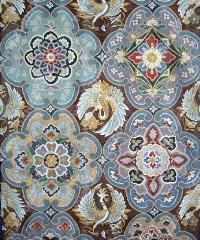 | ||
K'o-ssu or kesi (Chinese: 緙絲; pinyin: kèsī) is a technique in Chinese silk tapestry, admired for its lightness and clarity of pattern.
"K'o-ssu" means "cut silk", a name that comes from the appearance of cut threads created by the use of colour in the pictorial designs typical of the style (often copies of famous paintings). Unlike continuous weft brocade, in k'o-ssu each colour area was woven from a separate bobbin, making the style both technically demanding and time-consuming.
K'o-ssu first appeared during the Tang Dynasty (618–907), and became popular in the Southern Song Dynasty (1127–1279), reaching its height during the Ming dynasty (1368–1644). The style continued to be popular until the early 20th century, and the end of the Qing Dynasty in 1911–12.
